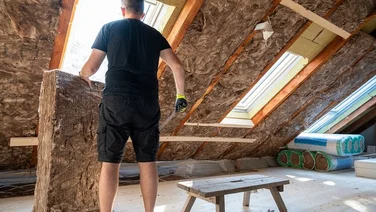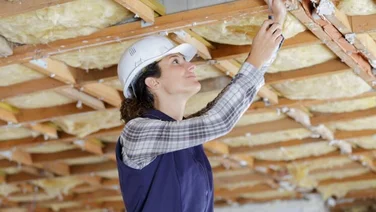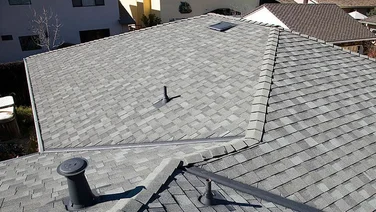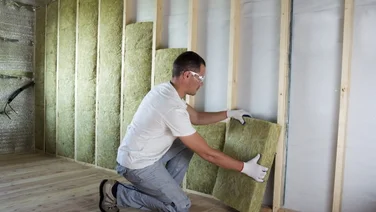- Getting spray foam insulation presents problems for homeowners
- It can damage roofs, the environment, and impact health
- While an effective insulator, it might be better to get a less damaging alternative
- Spray foam insulation can last up to 80 years with the right maintenance

Spray foam insulation is an effective way to keep your home warm, but not without problems. It’s not particularly environmentally friendly, for example, and it can make it difficult (if not impossible) to remortgage your home (more on that later).
We’ve examined the 5 key problems with spray foam insulation and, more importantly, how to solve them.
If you’re ready to get spray foam insulation, just fill in this simple form to start. All you need to do is put in a few details about your home. We’ll connect you with our trusted suppliers, and they’ll get back to you with obligation-free quotes for you to compare.
Get free spray foam insulation quotes
Answer a few quick questions, and our trusted installers will send you bespoke spray foam insulation quotes – for free.
1. It’s not eco-friendly
Even though spray foam insulation helps homes stop wasting energy (in turn, helping the environment), you can’t escape the fact that the majority of spray foam material insulation is just not eco-friendly.
In fact, it’s overwhelmingly made from nonsustainable materials, so it’s difficult to see it as the catchall solution for insulating our homes in the long run.
Older spray foam insulation is also a petroleum-based product, and as the world moves away from fossil fuels, it will inevitably become a thing of the past. However, more modern products are more sustainable (like recycled materials) and even bio-based options as an alternative.
It isn’t just what spray foam is made from either – applying it has big environmental risks that are hard to ignore.
When you apply spray foam, you need to use a ‘blowing agent.’ These are commonly made from a mixture of hydrofluorocarbons, and therein lies the problem.
Hydrofluorocarbons have an incredibly high ‘Global Warming Potential’ (GWP). GWP is measured from a base level of 1, with carbon dioxide (CO2) from burning fuel defined as the start of the scale.
Methane (CH4) is well-known as being a good deal worse for the atmosphere than carbon dioxide. Its GWP level is 28, which means it is 28 times worse for the environment than carbon dioxide.
How bad are hydrofluorocarbons then? Really, really bad – hydrofluorocarbons have an astonishingly high GWP level of 3,400, which would make releasing just 1 kilogram of the stuff into the atmosphere the equivalent of releasing 3.4 tonnes of carbon dioxide.
It is important to note, however, that the spray foam insulation industry has been moving towards low-GWP alternatives, such as hydrofluoroolefins (HFOs), in recent years. These materials have significantly lower GWPs, often less than 1, making them more environmentally friendly.
Some older types of spray foam insulation also contain volatile organic compounds (VOCs), which can harm the environment and human health. This is primarily an issue during the application, as “set” spray foam releases very low to zero amounts.
From a recycling point of view, spray foam insulation is pretty dreadful because of how it clings to roofing materials. This makes recycling any parts of your roof (for example, during renovation or even a full roof replacement) very difficult.
How to fix
Spray foam insulation might be good at keeping heat in and stopping energy wastage. But you can’t escape from the fact that most spray foam is made from unsustainable materials.
You could opt for more environmentally friendly insulation, such as cellulose insulation. This alternative is made from recycled paper and other plant-based fibres, making it biodegradable, unlike spray foam insulation.
Another alternative to ordinary spray foam insulation, called Icynene, is promoted as a much greener option. It’s made from recycled materials and contains no harmful gases, toxic chemicals, or synthetic blowing agents.
Most spray foams are applied using a toxic blend of highly damaging chemicals, but Icynene is applied using a 100% water-blown solution, making it a more eco-friendly approach to spray foam insulation.

2. Spray foam insulation can cause roof damage
Like other types of insulation, spray foam insulation can be installed in the attic or roof, under the floors, or in the walls.
When done correctly, spray foam insulation shouldn’t cause significant damage to your roof. However, if you’ve opted for “closed-cell” spray foam in your roof, you run certain risks.
Closed-cell foam is less porous than open-cell spray foam. This means that once it dissipates into your loft, the warmth will have nowhere to go. This might not sound like a problem, but the greater warmth has a hidden danger—expansion and contraction.
When things heat up, they expand, and subsequently, when they cool down, they contract. This process of expansion and contraction can damage roofs. Expansion and contraction cause gaps to appear in key parts of your roof, which decreases their structural integrity.
After a while of this process happening again and again, the likelihood of damage occurring increases.
Additionally, spray foam insulation can increase condensation in the winter, which can cause damage to untreated timbers. Damage to timbers can directly impact the structural integrity of your roof.
While other kinds of roof insulation, like fibreglass, can also cause similar issues, most other types of insulation don’t ‘stick’ to your roof the way spray foam does, making it harder to rectify once an issue is detected. For example, you can easily remove fibreglass insulation if you want, but spray foam insulation removal is difficult and potentially damaging.
One reason spray foam insulation can make your home difficult to mortgage (or remortgage) is the potential for damaging roofs. Of the 20 largest in the UK, TSB Bank, Skipton Building Society, Co-operative Bank, Principality, and equity release lender Aviva have publicly stated they will not lend if spray foam insulation is found in the roof space.
It is important to note, however, that most mortgage lenders do not have issues with spray foam insulation if installed correctly by certified professionals.
As the BBC reported, many (around one quarter, in fact) are reluctant due to concerns over poor fitting, which can lead to moisture buildup and roof timber decay.
According to the Insulation Manufacturers Association (IMA), spray foam can be beneficial if properly installed. However, the IMA is concerned that homeowners could be needlessly driven to “cowboy” removal companies if mortgage companies refuse to provide finance because of these concerns.
How to fix
You can avoid this by opting for open-cell spray foam insulation, but as this type of insulation is not water resistant, any leakage from your roof could turn it into mush.
Alternatively, you might consider ventilation options such as a window (a roof window like a Velux is ideal for this) or a roof vent. The downside is that these add to the overall cost, but a new roof would be a lot more expensive overall!
On average, a single Velux window costs between £305 and £1,800, depending on the size of the window and location.
Be sure to maintain your spray foam insulation every once in a while, too. Proper maintenance for spray foam installed on the roof includes regular yearly inspections to fix any holes or cracks.
Lastly, it’s best to avoid applying spray foam insulation near electrical outlets or recessed lights (the type embedded in the ceiling)—if the foam expands, it can damage the electrical wires.
Wondering whether spray foam is worth the hassle? Check out our page Is Spray Foam Insulation Worth It? to find out.
3. It can cause health complications
Spray foam insulation is known to cause a few health issues, including:
- Asthma
- Sensitisation
- Lung damage
- Other respiratory and breathing problems
There are chemicals found with some earlier spray foam types that contain carcinogenic properties (such as benzene), which can increase the chances of developing cancer. Some also contain toluene, which has been linked to neurological damage, and xylene, a substance that can irritate skin and eyes.
Additionally, the emissions released when applying spray foam can be damaging. We mentioned VOCs earlier, which react with chemicals in the air to form potentially dangerous compounds such as nitrogen dioxide.
This can lead to headaches and eye irritation if absorbed by someone over a long enough period. Again, however, it is important to note that most modern commercially available products must meet strict EU, UK, and US regulations, meaning they are highly unlikely to contain chemicals known to cause human health issues.d eye irritation if absorbed by someone over a long-enough period.
How to fix
Many potential health problems result from the excess gas left behind after installing the spray foam insulation. Homes will typically have to be evacuated for at least 24 hours after installation.
If the process isn’t done properly, the gas can continue to cause issues for a while afterward, increasing the risk of the health complications above. If you are in doubt, contact the original installer or a professional expert to give the spray foam insulation a once over and provide professional advice.
4. Spray foam insulation can cause bad smells
There’s a pretty unfortunate problem associated with spray foam insulation – bad smells, or more specifically, a fishy odour that seems to hang around for months after installation.
Whilst unpleasant, the issue is rare, especially if installed correctly by professionals.
For those unlucky enough to suffer from this, the cause is usually the installer’s fault. If they’ve applied the spray foam either too thickly or too quickly, the reaction that causes the spray foam to expand properly is interrupted.
Applying it too quickly makes the exothermic reaction get too hot, meaning the next layer doesn’t react properly. When you apply it too thickly, the layer underneath cannot expand as it normally would, leaving gaps and causing the spray foam to react incorrectly again.
When the foam reacts in the wrong way, it gives off excess gas, which causes a nasty smell. Another reason for this is that the installer doesn’t use the correct mixture of chemicals.
This doesn’t automatically mean the installer is at fault because oftentimes, they just work with the chemical mix they’re given.
How to fix
The key to avoiding this issue is to make sure you get a reliable, professional, and well-regarded installer who knows how to install spray foam insulation properly.
If you’re already dealing with the issue, fixing it is challenging, to say the least. You can’t simply ‘fix’ a bad chemical reaction without either removing the spray foam insulation entirely or waiting for the problem to fix itself.
The latter is almost always a bad idea because the sheer volume of material used in spray foam insulation means that the gases giving off the odour will linger for months (and, in some really bad cases, years).
Removing the spray foam is also incredibly difficult because it clings to surfaces effectively.
Other options include contacting the spray foam manufacturer, where normally you should be able to send a test sample of the insulation. They’ll see if they can determine the cause, but again, it’s not going actually to fix the problem.
Also, if your HVAC (heating, ventilation, and air conditioning) is in your loft, there’s a chance that the ducts are leaking. This might lead to a bad smell being circulated around your home (again, the smell is still there, so even this isn’t a fantastic solution to the issue).
5. Mould and mildew is (sometimes) a problem
When you use closed-cell spray foam, you get a much tighter insulating seal, which keeps a lot more heat in than other forms of insulation.
The major potential downside of this is that, by keeping in so much warmth, you can create the perfect environment for mould and mildew to flourish.
Of course, mould and mildew are not guaranteed with spray foam insulation—in fact, they are more likely to appear with fibreglass and fabric insulation.
One thing to note is that there is a conflict of interest between businesses promoting spray foam insulation and businesses promoting alternatives. The former insist that spray foam insulation is great for preventing mould and mildew, and the latter usually stresses the opposite.
It is also important to note that while this is a potential problem, it can be overcome with adequate ventilation and moisture control in the impacted areas. This could include something as simple as trickle vents or more sophisticated mechanical ventilation systems.
How to fix
Fixing mould and mildew is as simple as trying one of the many different recipes available online (bleach and water solutions are a popular option, or undiluted white vinegar if you prefer a more eco-friendly approach). Your best bet, however, is to prevent it from occurring in the first place.
For starters, you should ensure that when you get spray foam insulation, you don’t spray over surfaces that show telltale signs of mould and mildew. You, well the installer, should ensure that appropriate ventilation and moisture control strategies are included in the insulation design. As previously highlighted, this could include trickle vents, mechanical ventilation, and other gas/vapour control measures during the installation process.
Both only take 24–48 hours to appear, but at this point, the growths can be small enough to be missed entirely. So, you should first assess your loft for any problem spots before committing to insulating it with spray foam.
Alternatively, if you use open-cell insulation, your roof will be able to ‘breathe’ more effectively.
Summary
- Spray foam insulation is effective at reducing energy waste, but its traditional petroleum-based composition and high-GWP blowing agents raise environmental concerns, although modern alternatives are improving sustainability.
- Newer spray foams use low-GWP hydrofluoroolefins (HFOs) and meet stringent safety regulations, significantly reducing environmental and health risks compared to older products.
- Improper installation of spray foam, particularly closed-cell types, can lead to roof damage from expansion and contraction, increased condensation, and difficulties with repairs or mortgages.
- Health risks during installation, such as exposure to VOCs and off-gassing, can be mitigated by evacuating homes for 24 hours and ensuring professional application with modern, compliant materials.
- Bad smells caused by improper chemical reactions during application highlight the importance of hiring skilled, certified installers to avoid costly and challenging fixes.
- Proper ventilation and moisture control, along with thorough pre-installation assessments, can prevent mould, mildew, and structural issues, ensuring the long-term benefits of spray foam insulation.
Before considering installing spray foam insulation, it is important to note that the Homeowners Alliance (HOA) does not recommend installing spray foam until issues with lenders and rogue traders are resolved.
That being said, if you are considering insuring your home but are unsure about spray foam or any other product, fill out our simple webform to get an idea of which insulation will be best for your home. Enter a few short details about your home, and we’ll connect you with our expert installers.
They’ll get back to you with obligation-free quotes for you to compare.







